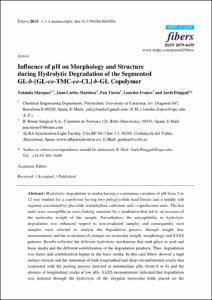Mostra el registre d'ítem simple
Influence of pH on morphology and structure during hydrolytic degradation of the segmented GL-b-[GL-co-TMC-co-CL]-b-GL copolymer
| dc.contributor.author | Márquez Lobato, Yolanda |
| dc.contributor.author | Martinez, Juan Carlos |
| dc.contributor.author | Turón Dols, Pau |
| dc.contributor.author | Franco García, María Lourdes |
| dc.contributor.author | Puiggalí Bellalta, Jordi |
| dc.contributor.other | Universitat Politècnica de Catalunya. Departament d'Enginyeria Química |
| dc.date.accessioned | 2016-05-02T10:20:47Z |
| dc.date.available | 2016-05-02T10:20:47Z |
| dc.date.issued | 2015-09-15 |
| dc.identifier.citation | Marquez, Y., Martinez, J., Turon, P., Franco, M., Puiggali, J. Influence of pH on morphology and structure during hydrolytic degradation of the segmented GL-b-[GL-co-TMC-co-CL]-b-GL copolymer. "Fibers", 15 Setembre 2015, vol. 3, núm. 3, p. 348-372. |
| dc.identifier.issn | 2079-6439 |
| dc.identifier.uri | http://hdl.handle.net/2117/86468 |
| dc.description.abstract | Hydrolytic degradation in media having a continuous variation of pH from 2 to 12 was studied for a copolymer having two polyglycolide hard blocks and a middle soft segment constituted by glycolide, trimethylene carbonate, and ¿-caprolactone units. The last units were susceptible to cross-linking reactions by ¿ irradiation that led to an increase of the molecular weight of the sample. Nevertheless, the susceptibility to hydrolytic degradation was enhanced with respect to non-irradiated samples and consequently such samples were selected to analyze the degradation process through weight loss measurements and the evaluation of changes on molecular weight, morphology, and SAXS patterns. Results reflected the different hydrolytic mechanisms that took place in acid and basic media and the different solubilization of the degradation products. Thus, degradation was faster and solubilization higher in the basic media. In this case, fibers showed a high surface erosion and the formation of both longitudinal and deep circumferential cracks that contrasted with the peeling process detected at intermediate pHs (from 6 to 8) and the absence of longitudinal cracks at low pHs. SAXS measurements indicated that degradation was initiated through the hydrolysis of the irregular molecular folds placed on the amorphous interlamellar domains but also affected lamellar crystals at the last stages. Subsequent heating processes performed with degraded samples were fundamental to reveal the changes in microstructure that occurred during degradation and even the initial lamellar arrangement. In particular, the presence of interfibrillar domains and the disposition of lamellar domains at different levels along the fiber axis for a determined cross-section were evidenced. |
| dc.format.extent | 25 p. |
| dc.language.iso | eng |
| dc.rights.uri | http://creativecommons.org/licenses/by-nc-nd/3.0/es/ |
| dc.subject | Àrees temàtiques de la UPC::Enginyeria química |
| dc.subject.lcsh | Copolymers |
| dc.subject.other | absorbable sutures |
| dc.subject.other | glycolide copolymer |
| dc.subject.other | hydrolytic degradation |
| dc.subject.other | ¿-irradiation |
| dc.subject.other | lamellar microstructure |
| dc.subject.other | small angle X-ray scattering |
| dc.title | Influence of pH on morphology and structure during hydrolytic degradation of the segmented GL-b-[GL-co-TMC-co-CL]-b-GL copolymer |
| dc.type | Article |
| dc.subject.lemac | Copolímers |
| dc.contributor.group | Universitat Politècnica de Catalunya. PSEP - Polimers Sintètics: Estructura i Propietats. Polimers Biodegradables |
| dc.identifier.doi | 10.3390/fib3030348 |
| dc.description.peerreviewed | Peer Reviewed |
| dc.relation.publisherversion | http://www.mdpi.com/2079-6439/3/3/348?trendmd-shared=0 |
| dc.rights.access | Open Access |
| local.identifier.drac | 17406835 |
| dc.description.version | Postprint (published version) |
| local.citation.author | Marquez, Y.; Martinez, J.; Turon, P.; Franco, M.; Puiggali, J. |
| local.citation.publicationName | Fibers |
| local.citation.volume | 3 |
| local.citation.number | 3 |
| local.citation.startingPage | 348 |
| local.citation.endingPage | 372 |
Fitxers d'aquest items
Aquest ítem apareix a les col·leccions següents
-
Articles de revista [181]
-
Articles de revista [2.226]


